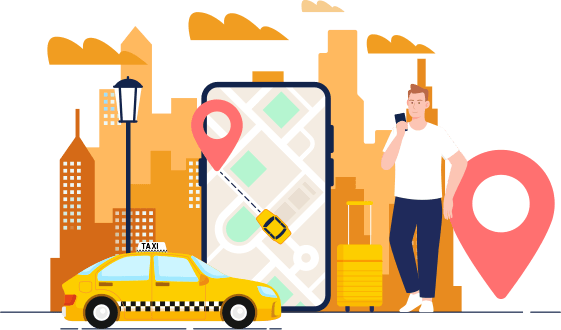The taxi app industry has experienced exponential development over the past ten years, mostly due to technological advancements, especially in artificial intelligence (AI). Artificial intelligence (AI) has completely changed the way taxi services run, from route optimization to demand forecasting and enhanced customer experience. However, as the user base of these apps continues to expand, scalability becomes a crucial issue. Ensuring that an app can handle the increased load without sacrificing performance is essential for maintaining long-term success. This article delves into the best AI techniques for improving the scalability of taxi apps, covering key areas such as demand prediction, route optimization, fleet management, customer service, and data security. Whether you’re a taxi app development company or an entrepreneur diving into taxi app development, understanding these AI techniques is paramount for building robust and scalable solutions in this rapidly evolving industry.
1. Demand Prediction
One of the foundational aspects of scalability in taxi apps is the ability to accurately predict demand. AI-driven demand prediction models leverage historical data, weather conditions, events, and real-time analytics to forecast the number of rides required at any given time. Here’s how AI can be employed effectively:
-
Machine Learning Models: Utilize supervised learning algorithms like regression models, time series analysis, and neural networks to predict demand patterns. These models can be trained on historical data to identify trends and seasonality.
-
Real-Time Data Integration: Incorporate real-time data such as traffic conditions, public transport availability, and local events. AI models can adapt to these inputs to provide more accurate demand forecasts.
-
Dynamic Pricing Algorithms: Implement dynamic pricing strategies based on predicted demand. By adjusting prices according to demand fluctuations, apps can balance the supply-demand equilibrium, ensuring availability during peak times while maximizing revenue.
2. Route Optimization
Efficient route optimization is crucial for reducing wait times, fuel consumption, and overall operational costs. AI can enhance route optimization through:
-
Real-Time Traffic Analysis: Utilize AI algorithms to analyze real-time traffic data and predict congestion patterns. Tools like Google Maps API or custom-built solutions can provide drivers with the fastest routes, avoiding traffic jams.
-
Geospatial Analysis: Implement geospatial data analytics to understand road networks better and optimize routes based on factors like road conditions, construction work, and historical travel times.
-
Multi-Drop Routing: For shared rides or deliveries, AI can optimize routes for multiple pickups and drop-offs, ensuring minimal detours and efficient ride-sharing operations.
3. Fleet Management
Scalable fleet management involves optimizing the use of available vehicles to meet demand efficiently. AI can enhance fleet management through:
-
Predictive Maintenance: AI can predict when a vehicle is likely to need maintenance based on usage patterns, reducing downtime and avoiding sudden breakdowns. Machine learning models can analyze data from vehicle sensors to forecast maintenance needs.
-
Automated Dispatch Systems: Use AI to automate the dispatching process, ensuring that the nearest available vehicle is assigned to a ride request, reducing wait times, and improving driver efficiency.
-
Fleet Utilization Analytics: Implement AI-driven analytics to monitor and improve fleet utilization. By analyzing data on ride frequency, duration, and locations, apps can optimize fleet size and distribution.
4. Customer Service Enhancement
Providing exceptional customer service is key to retaining users and maintaining a competitive edge. AI can enhance customer service in several ways:
-
Chatbots and Virtual Assistants: Deploy AI-powered chatbots to handle common customer queries and issues. These bots can provide instant support, freeing up human agents to deal with more complex issues.
-
Sentiment Analysis: Use natural language processing (NLP) to analyze customer feedback from reviews, social media, and support tickets. Sentiment analysis can help identify common pain points and areas for improvement.
-
Personalization: Leverage AI to offer personalized recommendations and promotions based on user behavior and preferences. Personalization enhances user experience and can drive higher engagement and loyalty.
5. Data Security and Privacy
As taxi apps handle vast amounts of sensitive user data, ensuring data security and privacy is paramount. AI can bolster security measures through:
-
Fraud Detection: Implement AI algorithms to detect fraudulent activities, such as fake ride requests or payment fraud. Machine learning models can analyze transaction patterns to identify anomalies and potential fraud in real time.
-
Data Encryption: Use AI to enhance data encryption techniques, ensuring that user data is securely stored and transmitted. AI can also monitor for potential security breaches and alert administrators to take corrective action.
-
Compliance Monitoring: AI can help ensure compliance with data protection regulations like GDPR or CCPA by monitoring data handling practices and identifying potential areas of non-compliance.
6. Scalable Infrastructure
A scalable infrastructure is the backbone of a robust taxi app. AI can play a pivotal role in optimizing infrastructure through:
-
Cloud Computing: Leverage cloud services to scale computing resources up or down based on demand. AI can predict usage patterns and automatically adjust resources to ensure optimal performance.
-
Load Balancing: Implement AI-driven load balancing to distribute network or application traffic across multiple servers. This ensures no single server becomes a bottleneck, improving response times and reliability.
-
Microservices Architecture: Adopt a microservices architecture where different functions of the app are decoupled and can be scaled independently. AI can help monitor and manage these services, ensuring efficient resource utilization.
7. Driver Management and Incentives
Effectively managing drivers and offering them incentives is crucial for maintaining a scalable operation. AI can assist in:
-
Driver Performance Analytics: Use AI to analyze driver performance metrics such as ratings, ride acceptance rates, and punctuality. This data can be used to provide feedback and design targeted training programs.
-
Incentive Programs: Implement AI to design dynamic incentive programs that motivate drivers based on real-time demand and individual performance. Personalized incentives can improve driver retention and satisfaction.
-
Scheduling Optimization: Use AI to optimize driver schedules, ensuring adequate coverage during peak times while avoiding overstaffing during off-peak hours. This helps in better resource allocation and cost management.
8. Scalable Marketing and Customer Acquisition
AI can enhance marketing efforts and customer acquisition strategies, crucial for scalability:
-
Targeted Advertising: Utilize AI to analyze user data and run targeted ad campaigns. Machine learning models can identify potential customers based on their behavior, preferences, and demographics.
-
Customer Segmentation: Implement AI-driven customer segmentation to create tailored marketing strategies for different user groups. This ensures more effective use of marketing budgets and higher conversion rates.
-
Predictive Analytics: Use AI to predict customer behavior and lifetime value. This helps in identifying high-value customers and devising strategies to retain them.
9. AI-Driven Analytics and Reporting
Robust analytics and reporting frameworks are essential for making informed decisions and scaling effectively:
-
Real-Time Analytics: Implement AI-driven real-time analytics to monitor key performance indicators (KPIs) such as ride volumes, revenue, and customer satisfaction. Real-time insights enable quick decision-making and adaptive strategies.
-
Predictive Analytics: Use AI to forecast future trends based on historical data and current patterns. Predictive analytics can inform business strategy, helping to anticipate challenges and capitalize on opportunities.
-
Custom Reports: Develop AI-powered tools to generate custom reports based on specific metrics and KPIs. These reports can be tailored to different stakeholders within the organization, providing relevant insights for each department.
10. User Experience Optimization
A seamless user experience is crucial for customer retention and satisfaction. AI can enhance the user experience through:
-
Personalized Interfaces: Utilize AI to personalize the app interface based on user preferences and behavior. For instance, frequent destinations can be highlighted for quick access, and personalized route suggestions can be provided.
-
Voice Assistants: Integrate AI-driven voice assistants that allow users to book rides, check status, and receive updates through voice commands. This can make the app more accessible and user-friendly.
-
Predictive Features: Implement predictive features that anticipate user needs, such as suggesting rides based on calendar events or past behavior. This proactive approach can significantly enhance user convenience.
Conclusion
Enhancing taxi app scalability through AI involves a comprehensive strategy that takes into account demand prediction, route optimization, fleet management, customer service, data security, infrastructure, driver management, marketing, analytics, and user experience. By effective use of AI technology, taxi apps can not only scale to meet rising demand but also improve operational efficiency, customer satisfaction, and overall business performance.
Investing in AI-driven solutions and consistently innovating based on new trends and technologies will be key to remaining competitive in the quickly changing taxi app market. The integration of AI not only facilitates scalability but also paves the way for smarter, more responsive, and user-focused services that can adjust to the changing demands of the urban mobility landscape.





